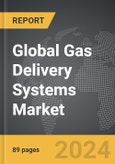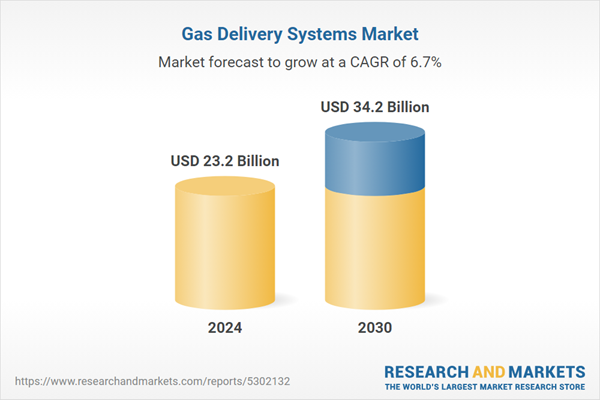The global market for Gas Delivery Systems was valued at US$23.2 Billion in 2024 and is projected to reach US$34.2 Billion by 2030, growing at a CAGR of 6.7% over the analysis period 2024-2030. This comprehensive report provides an in-depth analysis of market trends, drivers, and forecasts, helping you make informed business decisions. The report includes the most recent global tariff developments and how they impact the Gas Delivery Systems market.
Segments: Segment (Gas Delivery Systems).
Geographic Regions/Countries: World; United States; Canada; Japan; China; Europe (France; Germany; Italy; United Kingdom; Spain; Russia; and Rest of Europe); Asia-Pacific (Australia; India; South Korea; and Rest of Asia-Pacific); Latin America (Argentina; Brazil; Mexico; and Rest of Latin America); Middle East (Iran; Israel; Saudi Arabia; United Arab Emirates; and Rest of Middle East); and Africa.
The analysts continuously track trade developments worldwide, drawing insights from leading global economists and over 200 industry and policy institutions, including think tanks, trade organizations, and national economic advisory bodies. This intelligence is integrated into forecasting models to provide timely, data-driven analysis of emerging risks and opportunities.
Global Gas Delivery Systems Market - Key Trends and Drivers Summarized
What Are Gas Delivery Systems and Why Are They Crucial for High-Stakes Operations?
Gas delivery systems are sophisticated networks of equipment and components designed to precisely control, transport, and regulate the flow of various gases in critical applications across industries such as healthcare, semiconductors, chemical processing, and research laboratories. These systems encompass a range of products, including gas panels, pressure regulators, flow controllers, valves, and piping, all of which work together to ensure the safe and efficient movement of gases from storage to the point of use. In healthcare, for instance, gas delivery systems are essential for supplying medical-grade oxygen, nitrous oxide, and other therapeutic gases in hospitals and clinics. In semiconductor manufacturing, they play a pivotal role in maintaining ultra-high purity gas streams that are critical for processes like etching and deposition. Meanwhile, in research laboratories, precise gas control is necessary for experiments that require stable environmental conditions. The complexity of gas delivery systems varies significantly depending on the application, ranging from simple setups for laboratory gas supplies to highly complex, automated networks in large-scale industrial operations. Safety is a paramount concern, as many gases - such as hydrogen, ammonia, and chlorine - are hazardous and require meticulous control to prevent leaks, contamination, and explosions. As a result, gas delivery systems are designed to comply with strict regulatory standards, incorporating multiple safety features like pressure relief mechanisms, leak detection sensors, and emergency shutoff capabilities, making them indispensable in both high-risk and routine industrial environments.How Are Gas Delivery Systems Adapting to the Needs of Modern Industry?
The design and functionality of gas delivery systems have evolved significantly to meet the increasingly stringent demands of modern industrial and research environments, focusing on precision, safety, and reliability. One of the major trends is the adoption of modular and scalable gas delivery systems, which allow for easy customization and expansion. This approach enables industries like semiconductor manufacturing and chemical processing to adapt their systems quickly to new processes and changing production needs without the need for complete system overhauls. Another key development is the integration of digital technologies, such as smart sensors and programmable logic controllers (PLCs), which provide real-time monitoring and remote control capabilities. These features enable operators to track parameters like gas purity, flow rates, and pressure levels with high accuracy, allowing for early detection of issues and reducing the risk of costly downtime or hazardous conditions. Additionally, manufacturers are employing advanced materials such as corrosion-resistant alloys and high-purity stainless steel to prevent contamination and maintain the integrity of gas streams, which is crucial for ultra-high purity applications in the semiconductor and pharmaceutical industries. Compact and space-saving designs are also becoming more prevalent, driven by the need to optimize the footprint of gas delivery systems in tightly packed manufacturing and research environments. Furthermore, the focus on sustainability is influencing the development of gas delivery systems that minimize gas waste and energy consumption through innovative pressure control and recycling techniques.What Technological Innovations Are Shaping the Future of Gas Delivery Systems?
The future of gas delivery systems is being shaped by a series of technological breakthroughs that are enhancing their precision, efficiency, and safety. One of the most impactful innovations is the integration of advanced automation and digital control technologies, enabling gas delivery systems to operate with minimal human intervention while maintaining tight control over critical parameters. Smart gas delivery systems equipped with IoT connectivity and AI-driven analytics can now perform real-time diagnostics, predictive maintenance, and automatic adjustments, significantly improving reliability and reducing the risk of process disruptions. Another key advancement is in the field of microfluidics, which is enabling the development of miniaturized gas delivery systems that can control extremely small gas flows with high precision. These systems are particularly beneficial in emerging applications such as microelectronics, nanotechnology, and precision medicine, where conventional gas delivery setups are too large or lack the required control sensitivity. Additionally, innovations in valve technology, such as piezoelectric and solenoid valves, are providing faster response times and greater control accuracy, enhancing the performance of gas delivery systems in dynamic environments. The use of high-performance materials, such as chemically inert coatings and non-reactive polymers, is also expanding the range of gases that can be safely handled, opening new possibilities for delivering reactive or corrosive gases in specialized applications. Moreover, advancements in safety technology, such as automated leak detection and integrated shutdown systems, are making gas delivery systems safer than ever before, ensuring compliance with increasingly stringent regulatory standards.What’s Driving the Growth of the Gas Delivery Systems Market?
The growth in the gas delivery systems market is driven by several key factors, including the expansion of the semiconductor and electronics industries, increasing demand from the healthcare and pharmaceutical sectors, and the rising adoption of gas technologies in renewable energy and environmental applications. One of the primary drivers is the semiconductor industry’s continuous push for more advanced manufacturing processes, which require ultra-high purity gases delivered with extreme precision to create microchips and electronic components. As chip manufacturers invest heavily in expanding production capacities to meet global demand, the need for sophisticated gas delivery systems is growing rapidly. In the healthcare and pharmaceutical sectors, the demand for gas delivery systems is being fueled by the rising need for medical gases and the growth of biopharmaceutical production, where maintaining the purity and stability of gases is critical for ensuring product quality and safety. Additionally, the increasing focus on sustainability and environmental management is creating new opportunities for gas delivery systems in applications such as carbon capture, hydrogen production, and air quality monitoring. The adoption of gas technologies in these areas is driving demand for systems that can handle a wide range of gases with high efficiency and safety. Furthermore, the trend towards automation and smart manufacturing is supporting the market’s growth, as industries seek to implement gas delivery solutions that offer greater control, flexibility, and real-time monitoring capabilities. With these factors converging, the gas delivery systems market is poised for robust growth, driven by the dual imperatives of technological innovation and expanding applications across diverse high-tech and industrial sectors.Report Scope
The report analyzes the Gas Delivery Systems market, presented in terms of units. The analysis covers the key segments and geographic regions outlined below.Segments: Segment (Gas Delivery Systems).
Geographic Regions/Countries: World; United States; Canada; Japan; China; Europe (France; Germany; Italy; United Kingdom; Spain; Russia; and Rest of Europe); Asia-Pacific (Australia; India; South Korea; and Rest of Asia-Pacific); Latin America (Argentina; Brazil; Mexico; and Rest of Latin America); Middle East (Iran; Israel; Saudi Arabia; United Arab Emirates; and Rest of Middle East); and Africa.
Regional Analysis
Gain insights into the U.S. market, valued at $6.1 Billion in 2024, and China, forecasted to grow at an impressive 9.5% CAGR to reach $7.8 Billion by 2030. Discover growth trends in other key regions, including Japan, Canada, Germany, and the Asia-Pacific.Why You Should Buy This Report:
- Detailed Market Analysis: Access a thorough analysis of the Global Gas Delivery Systems Market, covering all major geographic regions and market segments.
- Competitive Insights: Get an overview of the competitive landscape, including the market presence of major players across different geographies.
- Future Trends and Drivers: Understand the key trends and drivers shaping the future of the Global Gas Delivery Systems Market.
- Actionable Insights: Benefit from actionable insights that can help you identify new revenue opportunities and make strategic business decisions.
Key Questions Answered:
- How is the Global Gas Delivery Systems Market expected to evolve by 2030?
- What are the main drivers and restraints affecting the market?
- Which market segments will grow the most over the forecast period?
- How will market shares for different regions and segments change by 2030?
- Who are the leading players in the market, and what are their prospects?
Report Features:
- Comprehensive Market Data: Independent analysis of annual sales and market forecasts in US$ Million from 2024 to 2030.
- In-Depth Regional Analysis: Detailed insights into key markets, including the U.S., China, Japan, Canada, Europe, Asia-Pacific, Latin America, Middle East, and Africa.
- Company Profiles: Coverage of players such as Ichor Systems, HARRIS, Praxair (Linde), Matheson (Taiyo Nippon Sanso), Air Liquide and more.
- Complimentary Updates: Receive free report updates for one year to keep you informed of the latest market developments.
Some of the 34 companies featured in this Gas Delivery Systems market report include:
- Ichor Systems
- HARRIS
- Praxair (Linde)
- Matheson (Taiyo Nippon Sanso)
- Air Liquide
- The Fuel Cell Store
- Environics
- CVD Equipment
- Watlow
Tariff Impact Analysis: Key Insights for 2025
Global tariff negotiations across 180+ countries are reshaping supply chains, costs, and competitiveness. This report reflects the latest developments as of April 2025 and incorporates forward-looking insights into the market outlook.The analysts continuously track trade developments worldwide, drawing insights from leading global economists and over 200 industry and policy institutions, including think tanks, trade organizations, and national economic advisory bodies. This intelligence is integrated into forecasting models to provide timely, data-driven analysis of emerging risks and opportunities.
What’s Included in This Edition:
- Tariff-adjusted market forecasts by region and segment
- Analysis of cost and supply chain implications by sourcing and trade exposure
- Strategic insights into geographic shifts
Buyers receive a free July 2025 update with:
- Finalized tariff impacts and new trade agreement effects
- Updated projections reflecting global sourcing and cost shifts
- Expanded country-specific coverage across the industry
Table of Contents
I. METHODOLOGYII. EXECUTIVE SUMMARY2. FOCUS ON SELECT PLAYERSIII. MARKET ANALYSISIV. COMPETITION
1. MARKET OVERVIEW
3. MARKET TRENDS & DRIVERS
4. GLOBAL MARKET PERSPECTIVE
UNITED STATES
CANADA
JAPAN
CHINA
EUROPE
FRANCE
GERMANY
ITALY
UNITED KINGDOM
SPAIN
RUSSIA
REST OF EUROPE
ASIA-PACIFIC
AUSTRALIA
INDIA
SOUTH KOREA
REST OF ASIA-PACIFIC
LATIN AMERICA
ARGENTINA
BRAZIL
MEXICO
REST OF LATIN AMERICA
MIDDLE EAST
IRAN
ISRAEL
SAUDI ARABIA
UNITED ARAB EMIRATES
REST OF MIDDLE EAST
AFRICA
Companies Mentioned (Partial List)
A selection of companies mentioned in this report includes, but is not limited to:
- Ichor Systems
- HARRIS
- Praxair (Linde)
- Matheson (Taiyo Nippon Sanso)
- Air Liquide
- The Fuel Cell Store
- Environics
- CVD Equipment
- Watlow
Table Information
| Report Attribute | Details |
|---|---|
| No. of Pages | 89 |
| Published | April 2025 |
| Forecast Period | 2024 - 2030 |
| Estimated Market Value ( USD | $ 23.2 Billion |
| Forecasted Market Value ( USD | $ 34.2 Billion |
| Compound Annual Growth Rate | 6.7% |
| Regions Covered | Global |









